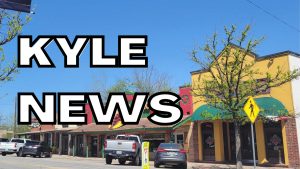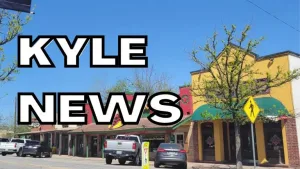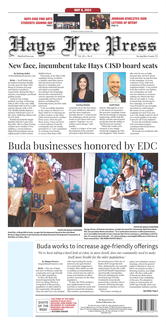The woman at the podium listed off a dozen or so species of songbirds that delight her young daughters by coming to their backyard feeder – tufted titmice, chickadees, wrens, finches and buntings among them. “I’m speaking on behalf of the birds that will lose their homes on the land behind our house” on Mather Street, Lisa Trahan told the Kyle City Council on Oct. 15.
“I also speak on behalf of my children, theirs is the generation that will confront the real problems of overdevelopment,” she continued, before lifting her young daughter Macy to the microphone. “There are cows back there …. And they’re like cutting down the trees,” the little girl said.
Those emotional remarks followed similar statements by a longer-time resident of the same neighborhood as council was poised to consider changing the zoning on 7.3 acres along Rebel Drive from retail services to single family residential.
“I’m concerned about what will happen to the animals that are in this field” behind her home, said Marlene Silcox, who has lived on Mather Street for more than 18 years. “I’m concerned about two-story homes going up behind me. It’s enjoyable to watch the sunsets and that’s going to go away too … I won’t even see the sky, much less the sunset.”
As Kyle struggles to keep abreast of its burgeoning population, fields, cattle pastures and shade trees are fast disappearing as homes go up in their place. And as has been typical for years, many of those new residents get on Interstate 35 each morning to drive to jobs in Austin or other points north.
That’s not likely to change, as rising home values in the state capital continue to edge out the middle class. The median price of a home in Austin hit $406,000 last month, marking an all-time high for September, according to figures from the Austin Board of Realtors (ABOR) Central Texas Housing Market Report.
“There is a lot of growth in Austin right now, that’s a big driver of growth in outlying areas like Kyle and Buda,” said Buda real estate broker J.D. Sanford. “You’ve got a lot of people who will, one, move to Austin for work and, two, decide housing is too expensive.”
According to the ABOR report, Austin home prices rose 11.9 percent from August to September, and all Travis and all surrounding counties experienced increases.
In Hays County, the median price of a single family home rose by 5.2 percent to $269,950 and single-family home sales rose by 9.7 percent to 329 sales. New listings declined by 0.6 percent during the same period while active listings were down by 3.5 percent. Hays County had a housing inventory of 3.1 months during September, a decrease of 0.2 percent.
In comparison, home values rose 9.1 percent in Travis County, 6.1 percent in Williamson County, 11.2 percent in Bastrop County and 6.1 percent in Caldwell County. Sanford noted that the increase wasn’t as steep locally, largely because of the number of homes being built. “
Hays has approved a lot of new houses. There’ a ton of new construction and increasing inventory like that can help keep prices a little more reasonable,” Sanford said. He also noted that Travis County’s stricter building codes leads to fewer development going in.
“Every year, I think maybe this will be the top of the market, but each year prices continue to rise,” Sanford said. Moreover, Austin’s economy is more dependent on high tech than oil. “As long as that sector is doing well Austin will keep doing well.”
Not only that, he said more and more new residents are coming from places where real estate is even more expensive. “Even our expensive houses are relatively affordable” for families coming from California, New York, Boston and Chicago. “As long as other major American cities are more expensive, you can count on Austin prices continuing to rise.”
Families new to the area aren’t the only group turning to northern Hays County as a respite from rising Austin prices. Sanford noted that people who bought homes in Austin 30 years ago for $100,000 are now selling them for three times that price. “They’re tired of living in Austin but they still want to live in Central Texas,” he said.
Another trend likely to continue is the likeliness of smaller lot sizes. Sanford explained that in years past, when homes in what were rural areas were built, they were on septic tanks. In fact, it was a county regulation that half-acre lots were required for on-site sewer.
“Once the sewer came out there was no reason to build on large lots anymore,” Sanford said. “There’s a lot of desire to live on large lots but no new product that delivers it,” he said, noting a “disproportionately high range of rising value compared to people living on small lots … They’re not building any more houses on large lots in the Kyle/Buda area anymore and those houses tend to sell for high prices because of it.”
Along with calling attention to the rising home prices, the ABOR report addressed what it called the need for a more flexible land use code.
Sanford agreed that more flexible usage – different types of home ownership, can also help keep prices down. He noted that Buda is about to get its first major condo development on Robert S. Light Blvd. That, he said, “will be a little test for the market to see if Buda’s ready for that,” breaking from the traditional single family residence mode.
As development continues, he said there may well be a place for condos and town homes. “There’s not a lot of that yet,” he said. “Maybe in the future.”
In the end that night, council voted to approve the rezoning that will bring new homes along Rebel Road. Assurances came from the developer in the form of promises to be a good neighbor, to preserve as many trees as possible and to maximize green space.
Mark Trahan, husband of Lisa and father of Macy, said he’s seen the result of unchecked growth growing up in Houston.
“My concern as a homeowner and what’s going on in general is the speed at which things are moving,” he said “Maybe we should slow down. Maybe we have enough homes for now.”
But the statistics are not now proving that fact to be true.







